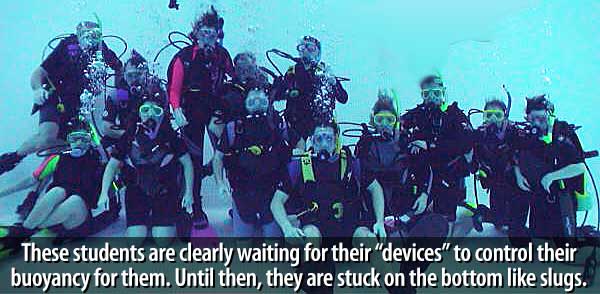![]() Odds are, you learned that the object in the accompanying picture is called a Buoyancy Control Device or BCD. The funny thing is, most of the companies that make this equipment — not to mention the majority of dive magazines and training agencies — don’t call it that.
Odds are, you learned that the object in the accompanying picture is called a Buoyancy Control Device or BCD. The funny thing is, most of the companies that make this equipment — not to mention the majority of dive magazines and training agencies — don’t call it that.
The most commonly used name for this piece of equipment is Buoyancy Compensator or simply BC. So where did this whole BCD thing come from? It largely came from just one individual.
In 1979, PADI published its first Open Water Diver manual. The principal author was PADI Training Director Dennis Graver — an individual who, over time, had a tremendous impact on diver training, yet has been largely forgotten.
Dennis, apparently, did not like the term buoyancy compensator (despite the fact that compensating for exposure suit compression was about the only thing the horse-collar BCs of the time were good for). His solution was to simply invent his own term: Buoyancy Control Device (BCD).
Although the term BCD appears exclusively throughout PADI’s training materials, the term never really caught on, outside of PADI stores and instructors. To this day, most people outside of PADI simply call it a BC.
If there anything horribly wrong with the term Buoyancy Control Device? Well, maybe not as wrong as global terrorism or world hunger, but there are two distinct problems with calling it a BCD.
- As BCs evolved into jacket- and back-floatation models in the early 1980s, their primary function became to serve as a tank harness and attachment point for other equipment. This is the only function most modern BCs fulfill 100 percent of the time. Buoyancy control is actually a secondary, part-time function — and results more from the fact the BC contains an integrated weight system than it does the fact it has an air cell.
- The biggest problem with the name Buoyancy Control Device, however, is the fact it’s misleading. The truth is, there is no device that can control your buoyancy for you. Only you can do that.
The term Buoyancy Control Device has resulted in several generations of divers who seem to think that buoyancy control primarily involves pushing buttons. This, in fact, helps explain why so many recreational scuba divers can’t control buoyancy.
As the accompanying illustration shows, the foundation of what has come to be known as the Buoyancy Control Pyramid is not BC use, it’s proper weighting — a fact that seems to elude most divers. Proper weighting has more impact on a diver’s ability to control buoyancy than any other factor. BC use is important, but secondary.
What is more important is the fact that buoyancy control requires active diver participation.
- Divers have to decide to use the least weight possible.
- Divers have to use breath control, when appropriate, to make minor, temporary buoyancy adjustments.
- Divers also have to use their BC’s air cells, when appropriate, to compensate for exposure suit compression (but never as a crutch to compensate for overweighting).
These are things no “device” can do for you. You have to do them yourself.
The fact is, we probably need a better, more descriptive name for BCs than buoyancy compensator or buoyancy control device — especially considering all that this equipment does beyond playing a role in buoyancy control. Something like Multifunction Device (MFD?) would be more accurate. Unfortunately, a term like this would likely devolve into Mother Fornicating Device faster than you could spit.
Absent a truly better name, why can’t we just stick with what the people who actually make this equipment use, and call it a BC? Why make things complicated? And why stick with names that mislead students as to what their equipment really does?
Thanks to my friend, well-known dive retailer John Wall for pointing out that “Devices don’t control buoyancy…you do.” John and his wife Susie are now enjoying a happy retirement running the photo concession at Buddy Dive Resort in Bonaire.


